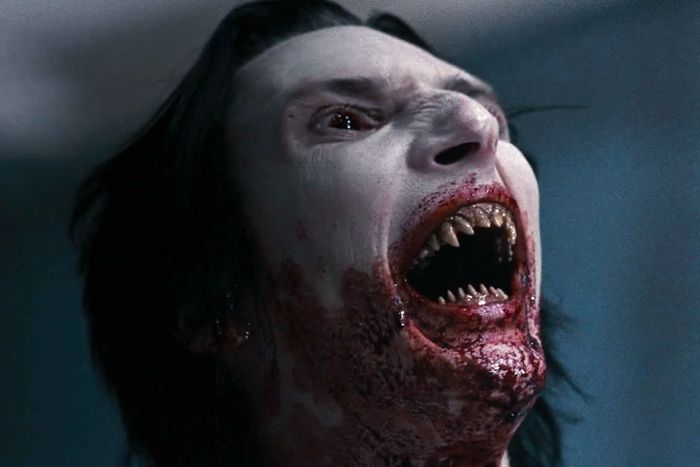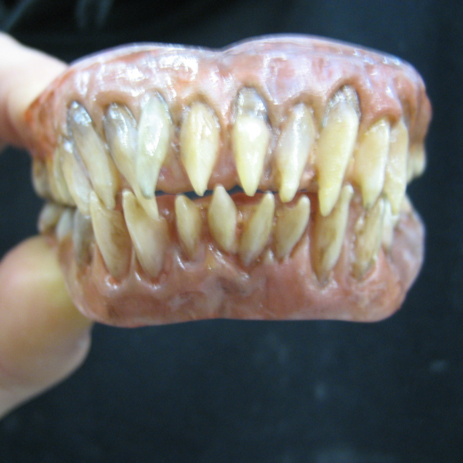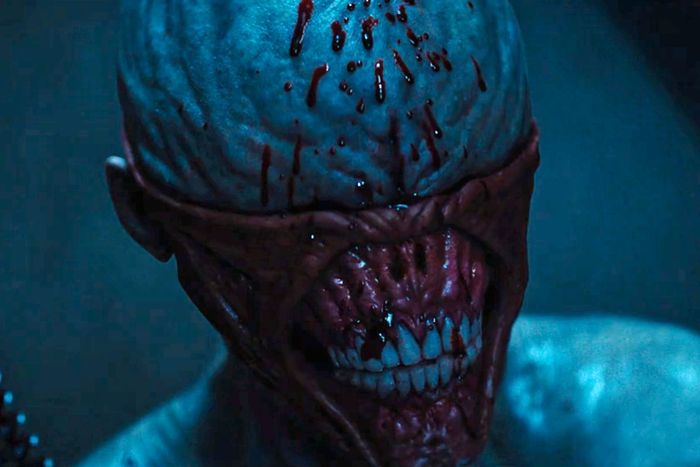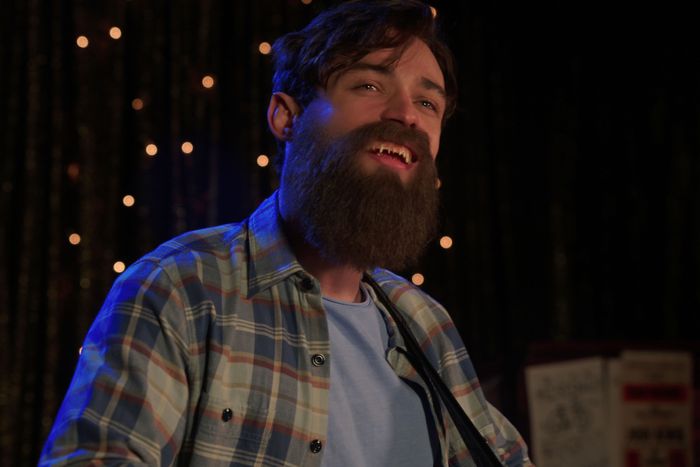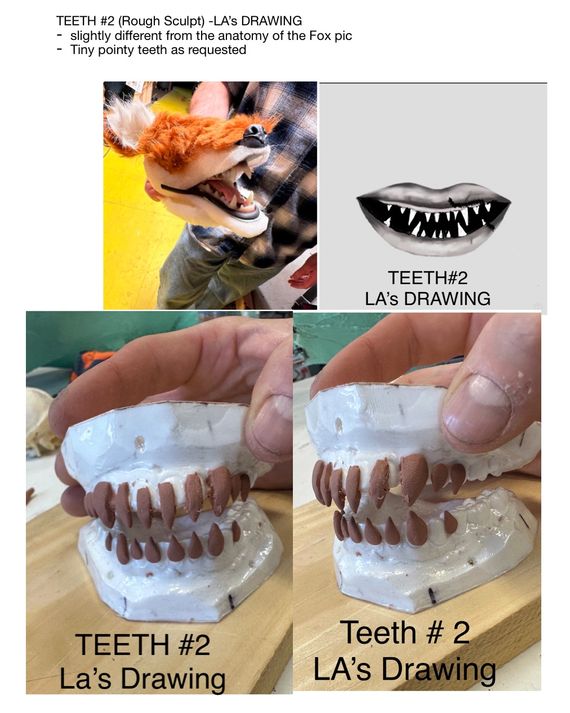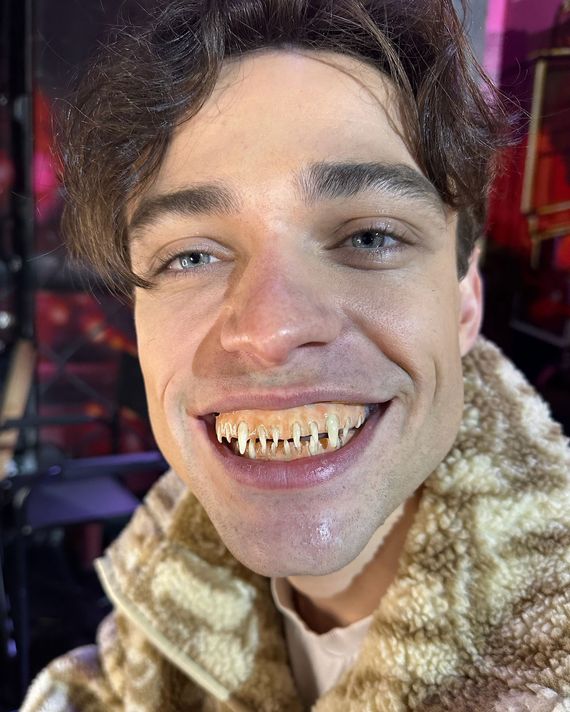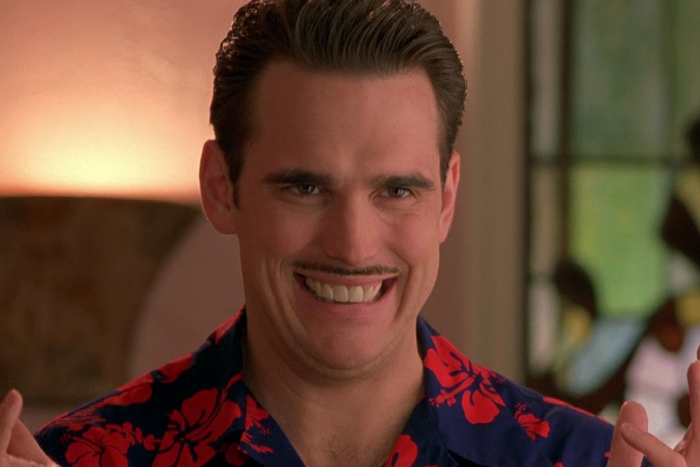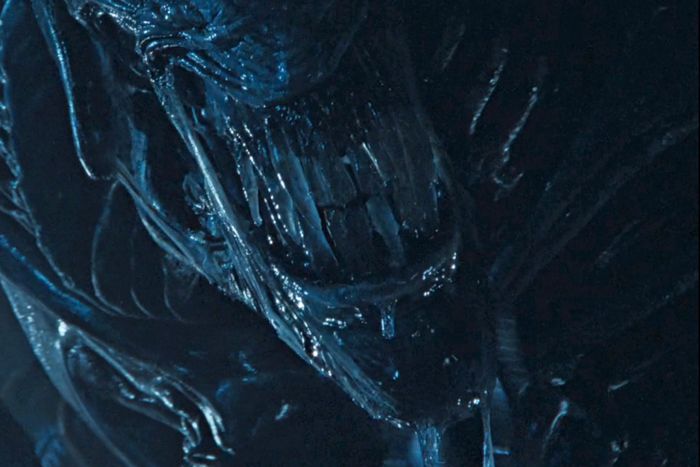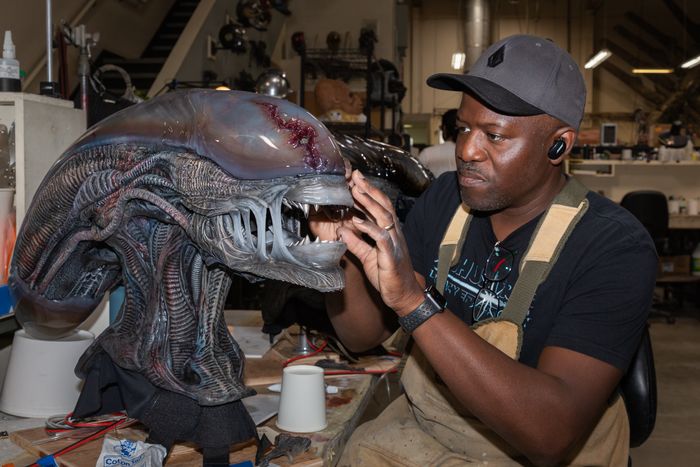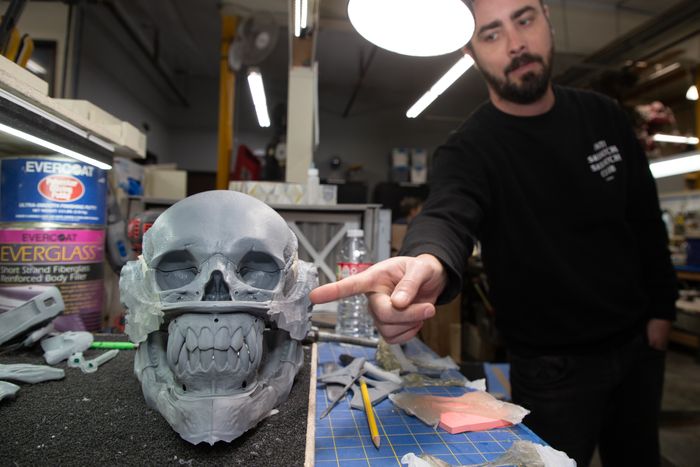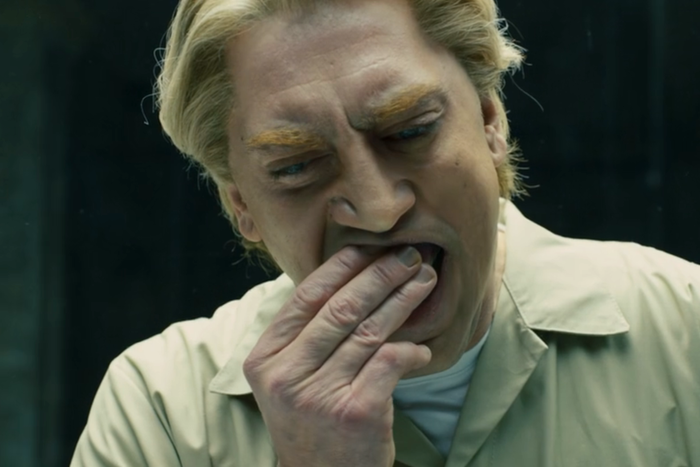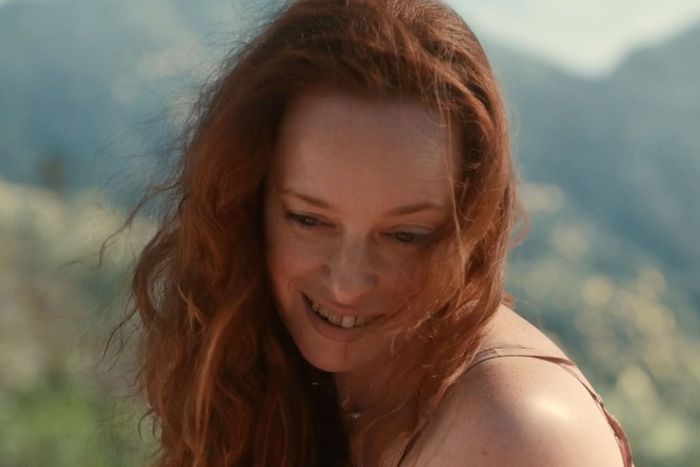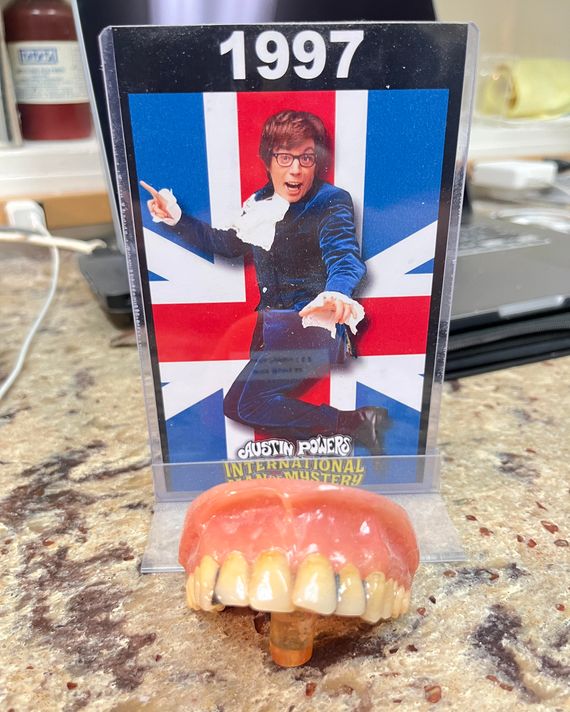
Transforming an actor’s teeth for a TV or movie project, says Tony Gardner of animatronic and prosthetic makeup-effects studio Alterian, Inc., is like a magic trick. No matter how big the literal dental pieces or figurative gag, every pair of teeth requires a sleight of hand to convince audiences that what they’re seeing in someone’s mouth is real. “When you’re working on somebody whose face people recognize, they know it,” he says. “If the person turns sideways, and suddenly their mouth is a little bit more of a muzzle because they’re having to close their lips a little further over the teeth, they know something’s wrong.” Avoiding that dissonance calls for meticulous work, and it’s an involved process for the dental technicians and prosthetics specialists who conceptualize how tops, bottoms, individual teeth, fangs, and other designs should look and create the needed molds; take impressions and measurements of the actor’s mouth for 3-D models; cast, sculpt, shape, and paint the fake teeth and gums; and then do final tweaks to ensure a correct fit.
Many of these same steps are used by dental professionals when crafting retainers, braces, and dentures, which is why many who work in this field have specialized training; for example, vacuum-formed plastic pieces, referred to by pros as vacu-forms, are similar to Invisalign or mouth guards. And because all these designs go into the delicate ecosystems of actors’ and stuntworkers’ mouths, the acrylics, paints, and other materials used must be approved by the American Dental Association. If they’re too tight, the pieces can damage the mouth or even snap teeth, as dental technician Gary Archer has seen happen with metal grills. If they’re too loose, the teeth can impede how an actor speaks or draw too much focus to their mouth. But for as precise as the work needs to be in terms of spacing, size, length, and density, it’s also a creative and effective way to transform someone’s look. “Every mouth is different. Every face is different. Everything is individual. You have to think about everything,” says Chris Lyons, director and owner of special-effects company Fangs FX.
To better understand how some of the industry’s most memorable teeth designs across genres in movies and TV came to be, ten dental designers, makeup artists, and showrunners shared their processes, and the answers range from stories about buying tons of K-Y Jelly to accentuate an alien queen’s fangs to a Bond villain wearing two pairs of fake teeth on top of each other.
30 Days of Night
Vampires have existed on film for nearly as long as film itself. The Wētā Workshop team, including special makeup-effects supervisor Gino Acevedo (whose creature-feature credits include teeth for the one-sixth–scale Godzilla used in Roland Emmerich’s 1998 film) and on-set prosthetics technician Gareth Jensen, were tasked by director David Slade to reinvent what a vampire’s fangs look like. The result was about 70 pairs of irregular, jagged teeth.
Gino Acevedo: We had meetings with David and he said, “I want them to be very different than your standard vampire with the fangs coming down. I don’t want any of that kind of stuff. I want their teeth to be like shark teeth, because I want them to be able to bite and to tear and rip the flesh apart.” We start off with a cast of the actor’s teeth and then from that we go through a series of making molds and then we do a clear vacu-form. We’ve got a clear vacu-form of their teeth impression, and with clay we sculpt all the changes that we want and then we go through a series of making molds. We pour in dental acrylic, which is the same stuff they use to make dentures out of, and we paint them up.
There were some times when we would get a bubble on the end of a tooth, and that was a real pain. You can patch it, but it’s never quite the same because it comes out as a little bit of a different color, and it’s a weaker point. We did lots and lots of teeth, tops and bottoms. We probably spent a good month sculpting all the teeth and getting them painted. The color for those was to try to make them look quite rotten and as gruesome as possible, thinking that they’re feeding a lot, eating a lot of meat, having a lot of rot and decay. And we painted the gums so the gum color wasn’t a nice healthy pink; it was more of a really desaturated pink color.
Gareth Jensen: There’s specific paints designed for dental monomers, and they’re like watercolors, where you build them up in layers. Dental monomer is very white until you really give it depth. You’re building in color and shape and emphasizing the sculpt to make it read on-camera. It’s a lot of small brushes and delicate work.
G.A.: Once we see the actors, then we have to fit them into their mouths. Some of the edges are a little bit sharp, and we have to trim things down to make them fit properly. We even had one guy who was actually missing a tooth in the front, so we incorporated that into his design. We would usually make two pairs for each actor and have another pair as a backup pair in case something happened to them. We had to tell the actors, “You gotta be careful to get used to your teeth. You can easily bite down on your lip or your tongue.” You could actually bite and hurt somebody. There were a few people there who accidentally bit themselves, and that’s the way it is.
G.J.: Luckily, not many of the actors had to deliver lines. They look terrifying on-camera, and the teeth look kind of ridiculous on, because they literally couldn’t close their lips around them. There was a lot of checking the teeth in and checking them out, making sure whose are where, making sure no one’s doing anything silly, like trying to drink coffee through the teeth. Some stunties would just chuck them at me, like, “I’m done. Take it.” [Laughs.]
G.A.: The blood that we used for the inside of the mouth, the base of that was Karo syrup, like corn syrup. We did something we did back on Lord of the Rings for the orcs. It’s Listerine with green and black food coloring added to it. The actors would get it, take a swig, swish it around their mouth and then spit it out. It would stain the inside of their mouth this gross color.
G.J.: The first time we saw all of them — the establishing shot of all the vampires turning up together and wearing their teeth — was a pretty proud moment. When you see everyone coming together on-camera, you’re like, Oh yeah, you guys are terrifying. You’re a lovely group of people, covered in blood and with fangs.
Hellraiser (2022)
Clive Barker’s 1987 film Hellraiser was a franchise-spawning work of grotesque and perverse gore, brought to life by designers including Robert Keen and Simon Sayce. Returning to the world of the Cenobites and their sex-as-pain, pain-as-sex vibe in the 2022 same-named reboot required a look that both pleased longtime fans and felt fresh. Special makeup-effects creators Josh and Sierra Russell of Russell FX, who had also worked with director David Bruckner on his horror films The Ritual and The Night House, created 15 Cenobite suits for the film. The iconically toothy Chatterer provided a unique opportunity to meld the old and new.
Josh Russell: The designs came from lead concept designer Keith Thompson and David Bruckner. They were working them out quite a bit before we were involved. Being a fan of the original myself, and understanding as a horror fan that you don’t want to step on things and destroy them, we’ve often said we probably wouldn’t have wanted to do that movie if it weren’t for the director that we knew would carry it forward.
The Chatterer was the only other legacy character in the remake besides Pinhead. You can’t screw it up because people are looking for it and cheering for it. We got Jason Liles, who was the first member of the Cenobite cast who was hired. The sculptor that we hired, Mike Rotella, he was the first person we hired on our crew to come in and start working on that.
Our first design was much more of a smooth, egghead look, and we had the idea that he should be more monstrous: much longer, elongated teeth that were based on a horse reference, and really peeling the gums back a lot farther. There’s a questionable orifice in the front of his forehead. [Laughs.] When our director came to see it, he kind of freaked out and then he went home and slept on it and came back and said, “Maybe you’re right. We do need a monster in this monster movie.” We ended up meeting in the middle. We took it back, probably to one-third, from those big, long horse teeth. The teeth are incorporated into the sculpture, and they’re all cast in the same silicone rubber. There is a fiberglass underskull that’s operated by a motor in the back, and that’s what makes the mouth open and close. It’s so satisfying to hear on set. The reason we went with an animatronic is because we didn’t want to deal with repairing chipped teeth for eight weeks in Serbia. Then we did make a half-version of it with some hard teeth in it so we could do real quick insert shots of the teeth just by themselves.
Just based on the overall shape and design and the bulk that the costume puts on the character’s teeth, dentures would have been so small compared to the rest of it, or it would have been so uncomfortable to have this big Walking Dead–style denture piece hanging out of an actor’s mouth like a duckbill. The character lends itself to being able to do it that way, too, because it just has one motion, so it’s easier for us to control that with a remote than to have an actor working out his jaw all day. We wanted to make those puppies chomp. The whole head piece is all one piece that zips up the back, and it zips on at the shoulder bust to the rest of the costume. Once you put on that helmet that has the animatronic control, you put the silicone skin on, and it stretches all the way over it.
Sierra Russell: The mask was so tight on Jason, we had to make some adjustments to try to make it as comfortable as possible.
J.R.: Every time you put the mask on, it would sit on him in a slightly different way and have a slightly different effect on how the teeth operated, and that was the most important part of the character. There was one night we were in the woods, and the teeth weren’t working right, and one of the producers was panicking. A wire had come loose. We were looking at it with a flashlight, and he was like, “This is the most important Chatterer scene! What are we gonna do?” [Both laugh.] We figured it out, and it’s great. It’s the coolest Chatterer scene; it’s before he dies. This is the most fun we’ve had doing teeth.
S.R.: He’s the toothiest we’ve done, for sure.
Girls5eva
In the absurdist world of creator and showrunner Meredith Scardino’s Girls5eva, anything is possible: a girls’ group making a resurgence after decades of irrelevance, a machine in a school cafeteria that turns a whole chicken into perfectly formed nuggets, and a fox-to-human teeth transplant Girls5eva member and dentist Gloria (Paula Pell) performs to help her new friend Gray Holland (Thomas Doherty), the world’s biggest pop star, fake his own death, escape fame, and start a new life freaking people out at remote open mics. “Thomas is stunning and then he puts those teeth in his mouth. And we went, ‘Wow, that’s a whole moment,’” says makeup-department head La Sonya Gunter.
Meredith Scardino: When Paula realizes that Gray actually feels trapped, is she there for her friend? We thought the most extreme version — which is usually what we do — would be to help him. Then we said, “Now we have to do a little scene where Grey Holland is happily living in anonymity with a set of fox teeth.” We consulted La Sonya and said, “Thomas Doherty has a beautiful set of teeth. How do we make it look like he has these little jagged, little spaced-out fox teeth?” Then she went to work.
La Sonya Gunter: I’m drawing out sketches, and I’m thinking of B-movie, pointy, scary teeth. My first one was a hand drawing, and it was like Halloween teeth. I kept sending Meredith sketches, and she sent me sketches back.
M.S.: We didn’t work with a live fox, because Paula is very concerned about making sure animals are humanely treated. We actually had a puppeteer make a fox puppet, and those are technically the teeth we were matching. But they also were Muppet-y, so we were making the real ones that go in Thomas’s mouth more like little demon daggers.
L.S.G.: I went to special-effects makeup artist Jason Milani, who’s amazing. He made several different sculptures, and he came in and sat with Thomas and created a mold with alginate. After they finished the mold, Jason made it out of acrylic. It’s just like going to the dentist, except you’re not going for fox teeth. He painted the teeth with dental paint. After Jason got the mold, those teeth were literally made in about two days. I actually ran out in the street on the break and grabbed the teeth because he couldn’t stop in the car.
M.S.: He couldn’t stop! He threw them out the window. [Laughs.]
L.S.G.: Thomas tried them on, and we messed with them a little bit. We made the gums a little pinker. Because of the teeth being made of acrylic, I was able to use Skin Illustrator. It’s a palette, and we use it to cover tattoos.
M.S.: Everything had to be shaved down and spaced. I think we elongated the canines.
L.S.G.: We took a few out. Literally, the day we were doing it, I was like, “They’re not small enough!” I’m taking a file and I’m filing them down. I’m making them pointy. They’re so delicate, and I’m being very delicate, but I’m also like, “I just gotta file them down a little bit more!” It was fun.
M.S.: We had such a jam-packed schedule, it was the last thing up in the day. It was even labeled “as time permits.” We did a few takes, and he nailed it. He had a couple lines before he revealed the teeth. It was funnier to just cut to it, and you see one of the most handsome people ever with these teeth. He was such a dream guest star — so game for everything. And then when he left, his last day, we got him a cake that had a fox on it.
There’s Something About Mary
Years before the over-veneer-ification of Hollywood, There’s Something About Mary introduced the concept of slightly too large, slightly too perfect teeth to the average comedy viewer. While trying to woo Cameron Diaz’s titular Mary, private investigator Pat Healy (Matt Dillon) misunderstands an eavesdropped-upon compliment she pays to another man about his teeth: “The bigger, the better … Nothing’s sexier than a mouthful of pearly whites.” He’s sure his capped teeth will win her over, a certainty that special makeup and animatronic-effects supervisor Tony Gardner of Alterian, Inc., had to communicate with an unsettling set of veneers.
Tony Gardner: After reading the script, I remember sitting out front of my home so my kids couldn’t hear me asking detailed questions to Peter and Bobby Farrelly about what their expectations were for certain things. They got into a lot of detail about saggy old-lady boobs and dogs getting set on fire, but they also mentioned that Matt Dillon’s character was going to try and woo Cameron Diaz and do what he considered to be an upgrade to his appearance. Peter described it as someone who was looking to re-create the confidence and authority that Tony Robbins has. Tony Robbins is a big guy with big hands and a big head and big teeth, but Matt Dillon’s character, who was trying to woo Mary, was going to take that at face value and just go for a look that embodied that literally, on a much smaller head. It meant the teeth would be oversize but perfect, shiny white. It still had to balance out with his lower teeth, though, because it affects diction if you do the lower teeth as well. There’s a learning curve there, and Matt was going to have to wear these through most of the movie.
We made three sets to figure out the right size, and it was a tricky balance because it was really easy to go too cartoony, almost like Jim Carrey in The Mask, where there’s too much schtick involved. Given the angles to Matt’s face, the difference in size where it would make an impact was just incremental. We sculpted the largest of the three on casts of his teeth, and we could hold the cast on an articulator to open and close the mouth, and you could see how cartoony that was. That honed us in on pushing more toward real. The thing that I’ve learned is that you need to keep dialing it back and dialing it down. How little material do you actually need to add to the actor in order to achieve the effect you’re after? Peter described it as “Find that fine line where you’re walking between reality and parody. Just push it the tiniest little bit toward parody, and see what you can do.”
Making teeth or anything for an actor, it’s a shared sale. You have to make sure it balances with their features: the width of their nose, the distance of their eyes. We’re doing half of the idea and then it’s the actor’s job to sell it and ground it in reality, and Matt was fantastic with it. It was literally just an upper veneer that wrapped around the front, all the way as far as we could go on the sides and not push his face up, because he has really striking cheekbones. The teeth are all fake, and so are the gums. His biggest concern was the fit and the integrity of them staying on through a lot of exaggerated facial expressions. We gave him a pink set as a practice set, just cast out of the same color of acrylic that gums are cast in, because it was a throwaway thing. He would wear them around a lot and forget and smile at people, and apparently it was fairly jarring. [Laughs.]
People still come up to me about it. They assumed that Matt had actually gotten veneers, which I thought was hilarious. The fact that people think this stuff is real is the best compliment you can ask for.
Aliens and Alien: Romulus
The xenomorph inspires a not-insignificant amount of fear thanks to its maximalism. That extra-long body and those spindly fingers, the acid blood, and not just one mouth full of razor-sharp teeth, but two. After Ridley Scott introduced the creature in Alien, it didn’t seem like that idea could get scarier — and then Aliens unveiled the alien queen. “We took the responsibility very seriously, and we wanted to do it justice and make Stan Winston extraordinarily proud of it, because it was a massive responsibility. You make it as dangerous looking as it can be,” says Shane Mahan, the then-coordinator of creature effects who also sculpted the alien queen’s head. With the legendary Stan Winston Studios, Mahan worked on other projects like The Terminator and Interview With the Vampire; as co-founder of Legacy Effects, Mahan has designed prosthetics, makeup, and various effects for dozens of films like Iron Man, The Shape of Water, and Alien: Romulus, his return to the franchise.
Shane Mahan: We were working on The Terminator, and that was really the first team effort of Stan Winston, myself, James Cameron at the helm of writing and directing, and other team members John Rosengrant, Tom Woodruff, and Richard Landon at the time. It really established a working group of artists that carried on for many, many years with Stan Winston, and it also established a very strong bond with Stan and James Cameron.
The issue of the teeth was a very strong consideration, because we were such fans of H.R. Giger’s work and Ridley Scott’s first Alien xenomorph creature, which had silver metallic teeth. Jim and Stan were of the opinion of creating their own iconic vision, and they didn’t necessarily want metallic teeth on the queen because they were so large. Her teeth were about four, five inches long in some cases, and they just felt like it would be too glaring and not organic enough. There were certain areas of it that were translucent — I was striving for a lot of translucency on her face anyway — but certain materials weren’t available back then to make the skin translucent. So it was deemed to make her teeth a hard, clear urethane, much more like a deep-sea fish, and I think it was the right choice.
Back then, we worked from sketches of the queen and a maquette, which is a miniature sculpture. We would take Stan and Jim’s pencil sketches, and then we’d start our own versions of the sculpting process in quarter scale of the queen. I had eight weeks to sculpt the queen’s head, and other artists were working on various parts of her body. It was one of the largest creatures for effects that had been accomplished at that point.
I would mock up teeth out of a plasticine, mold them, cast them in plaster, polish them down, and then insert them into the WED clay so that they wouldn’t dry out and they would sustain the weeks of time. They were remolded into clear urethane, inserted into her fiberglass understructure, and painted. There were probably three, possibly four, heads made, and dozens and dozens and dozens of teeth. The saliva was a food additive called methylcellulose. It’s added to other things that thicken things up. Also, we used tons of K-Y Jelly. I think we bought every bottle of the stuff in the Windsor, U.K., area for months at a time, from every pharmacy. It was always a fun thing to go buy 100 bottles of K-Y from the local pharmacy.
The queen’s tongue is about four feet long. There’s a driving mechanism on a pulley system that would actually shoot out. That was all manually driven. You had to be very careful so you don’t hurt Sigourney Weaver. You don’t want to drive that inner mouth through and smash those teeth out. To break those teeth and have to fix them on set would be an absolute disaster. You have to open the mouth and then shoot that mouth out and close it. And that inner mouth also had an inner mouth mechanism that opened. Those teeth weren’t translucent. Someone who made the inner mouth cast them up out of a different type of acrylic than the clear, and I’m really not quite sure why. They should have been clear. It was unintentionally different.
I remember a very interesting lesson I learned. I had a Polaroid photograph of the queen, and I was going to give an update photograph to show Jim something on set. And I said, “Hey, Sigourney, do you want to see the queen? I have a picture of the queen.” And she was like, “No, I don’t want to see it until I see it on set, because I want my reaction to be very real.” I felt rather ridiculous for even asking. But then it made me think, That’s the perfect response because that’s why you make it look the way it does. When she’s fighting it and the teeth are snapping and chomping, you want that kind of visceral snap reaction. And that happened on the newest film as well.
Alien: Romulus ties into Aliens. It was a complete surprise to me and to the other partners here at Legacy. I didn’t think we were ever going to work on an Alien film ever again. Romulus was very unique because the work was divided among three different FX companies. Fede Álvarez wanted us to do the xenomorph, the cocoon, the birthing scene, the Offspring, and the Rook character. Our xenos no longer have clear teeth; they’re back to being very metallic, large, sharp, and very vicious. And the interior mouth was corrected. They weren’t enamel colored this time; they were silver. Those details are logged away in the back of my brain as things that, if and when you get a second chance to go back and fix certain things that you always wanted to fix, you get to do it again.
The Offspring hybrid was always meant to be a prosthetic makeup and not an animatronic creature. At one point it was going to be a small child, but it ended up kind of developing into Robert Bobroczkyi, the wonderful actor that Fede found. Prosthetic body sections get glued to his body everyday — the silicone chest and silicone back section, head piece, face piece, and neck, and hands and elbow sections and legs. There’s 13 or so different pieces that get glued and get body-paint detail. He’s wearing a set of teeth. You don’t want to have human teeth in a very creative makeup design like that because it gives it away. You have a facsimile of shiny teeth, sharp teeth, strange teeth, and dark gums to complete the makeup. They’re veneer teeth that pop into place. They look sharp, but they’re not horrifyingly sharp. There were probably four or five sets of acrylic and vacu-form teeth that are molded to his teeth so that they go in and out comfortably. You make that many in case they break, or they might fall out of his mouth during an action scene and fall into the set and never be found again. These things happen all the time.
Skyfall
It takes a memorable image to overshadow Javier Bardem flirting with Daniel Craig in Skyfall, but Bardem revealing a set of horribly decayed-by-cyanide teeth just about does it. Chris Lyons, director and owner of Fangs FX, made three teeth tops for Bardem’s villainous Raoul Silva, including rotten teeth that hid underneath the character’s veneers. Stacking two pieces on top of each other was a “one-off” that Lyons hadn’t done before and hasn’t done since.
Chris Lyons: The makeup designer, Naomi Dunn, phoned me and said, “We got the Bond movie.” It was the first Bond movie I worked on. They did this visual-effects mockup, and it showed him taking the teeth out and his face caving in and then leaving all these rotten teeth. Javier wears our teeth throughout the film, and in that one famous scene, he is wearing two sets of teeth, one over the top of the other. He takes out the good teeth to reveal the rotten teeth. Then in his hand, he has a prop piece that has a big lump of metal on it, which is like the jawbone. We did a big chrome jaw piece, so you see him taking it out, and he’s got it in his hand, and then the visual effects caved his face in. Unfortunately, when they did that, they sort of fuzzed out the dirty, rotten, broken teeth as well. Getting two sets of teeth into his head without distorting his face, and getting him to talk, was a challenge. That was a one-off. But he was well up for it.
We’ve done rotten, smashed teeth, but not to that degree. The rotten teeth are less than a millimeter thick. The set that goes over them is a couple of millimeters thick. And then the good pair he wears all the way through are about two and a half, three millimeters, so once we’d made the good set he wore all the way through, we then had to get the two sets within that boundary.
We’ve done all the Harry Potters, an Indiana Jones, Star Wars, Game of Thrones, House of the Dragon, Doctor Who. But the one that was always eluding me was a Bond and then I actually did the next two Bonds as well, so I’m very happy. The cheek piece ended up going to the Bond archive.
The Righteous Gemstones
No, not Uncle Baby Billy’s teeth — his wife Tiffany’s. Walton Goggins’s braggadocian, semi-washed-up former child star proves his devotion for much-younger fifth wife Tiffany (Valyn Hall) by paying to have her teeth fixed in the series’ first season. Tiffany is insulted by her new (and older) nieces and nephews as “feral” and considered lower class thanks to what they dismissively call that “mouth,” but Uncle Baby Billy insists that “even with them old stained, crooked things, I still love you with all my heart.” Dental technician Gary Archer, who has more than 300 credits (including this summer’s MaXXXine, Blink Twice, Reagan, and Deadpool & Wolverine), designed both sets of dental prosthetics for Hall, but recused himself from the series’ second season after seeing Hall’s new smile.
Gary Archer: They wanted her to have some pretty bad teeth in the beginning with something that looked like a bad crown at the front of her mouth, like someone had done a crown in the wrong color and it just didn’t fit right, and then she gets her teeth fixed. We did the bad teeth and then we did a set of good teeth. We did a lot of the fittings via Zoom because Valyn was in New York and I was in Los Angeles, and I was sending her these pieces. She was popping them in, the director was looking at them. We had a bad, a very bad, and extremely bad concept. They were different stages of staining and angulation. They didn’t want to go with the extreme concept because it would have been too comedic. The whole key to making a set of teeth is when they’re on-camera to make it look like, Wow, I didn’t even realize they were wearing a set of teeth.
When we did the veneers, I made what I would consider not Hollywood perfect, but pretty perfect-looking teeth. We manufacture things out of dental acrylic. We use lacquer stain on them. Anything with the mouth has to be ADA approved. There were two looks created, and of those looks, there were three of each. She liked the way that the good teeth looked, and so she ended up going to a dentist and had veneers done that were very similar to what we had made for her. When she came back for season two to have impressions done, I was like, “Whoever made your veneers did a beautiful job.” I spoke to the production people and I said, “Here is what we made originally to make the smile look good, and this is Valyn now, and you can see her teeth are pretty close to what we made. For continuity purposes, you don’t need to put a set of veneers on top of a set of veneers. They’re gonna end up looking bulky, and they’re going to be sticking out.” Nobody likes to turn down money, but you’ve already got something nice. I can’t make it nicer than nice.
Austin Powers: International Man of Mystery, Austin Powers: The Spy Who Shagged Me, and Austin Powers in Goldmember
A character becomes iconic when a generic Halloween store costume description like “British spy teeth” immediately conjures an image in your mind, and Gary Archer knows Austin Powers will be his legacy. Since the 1997 film, “so many people have copied the teeth,” Archer says, but he also (with a laugh) says he’s been “absolutely pilloried … by people going, ‘It’s your fault. You started this whole myth of bad British teeth.’” He adds that “dodgy teeth” exist all around the world, but very few of those mouths are as famous as that of Mike Myers’s sexually progressive spook.
G.A.: I was contacted by makeup artist Matthew Mungle, who said, “I’ve got an actor who wants to get some teeth done. I’m going to send him over to you.” Mike Myers came to me, and in this book of British teeth — I can’t remember the actual name of the book — he showed me what he wanted. The whole gag was that he had to have these horrible 1960s prototype British teeth. I based them on some pictures that he sent and on some people I’ve met in my lifetime. Everything was done with denture acrylic and dental acrylic. The first set of teeth we created, he loved. Literally out of the box: “They’re perfect. Don’t change a thing.” That’s one of the reasons I remember it so well, because there was no backward and forward, fixing and fiddling around.
There were three versions of the concept — bad, really bad, and horribly bad — and they used all three of the concepts. He went backward and forward on his timeline with them. You’ll notice some of his teeth, they’re just a little bit softer. The angles are a little bit more rounded, they’re less pronounced, they’re not as dark. Nothing was ever wasted. What does change in the series is he gets his teeth fixed, but when he goes back in time, he gets his bad teeth back. If you look at Austin Powers without the teeth, it’s Mike Myers wearing sunglasses and being funny. I hate to make it about the teeth, but without the teeth, the character was missing something.
We did teeth for Verne Troyer; we did teeth for Michael Caine. We did the gold teeth for Goldmember. If I leave a legacy behind me, Austin Powers will be it. I still have an original set in the shop. I’ll never sell them; I’ll never give them away. They’ll be with me forever.



